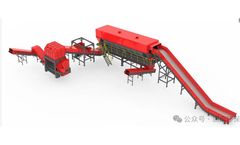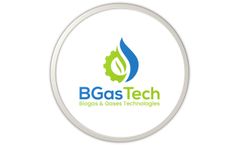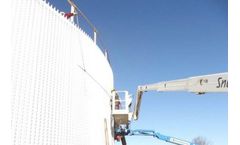Methane Production Articles & Analysis: Older
50 articles found
Integrated equipment combination, annual production capacity can reach 150,000 tons The biomass resource processing system is freely combined with "modular, integrated, automated" environmental protection equipment, and effectively prepares various biomass raw materials into several types through crushing, screening, iron removal and other RDF/SRF alternative fuel preparation ...
Optimising biogas production Monitoring gas components in biogas plants can maximise methane production, a primary energy source. ...
The EU Commission has proposed to increase the bio-methane production from 3 billion cubic meters in 2020 to 35 billion cubic meters by 2030. ...
The anaerobic digestion of these sludges from wastewater treatment produces biogas, which, due to its concentration in methane (CH 4 ), constitutes a biofuel that can be used for energy production. ...
As a type of biofuel that not only eliminates waste but also produces a valuable energy source, biogas production has increased in recent years. According to the US Energy Information Administration, biogas contributed to approximately 11.5 billion kilowatt-hours of electricity back in 2017. ...
Project: Sandoz Industrial Products S.p.A. - Novartis Group Location: Rovereto (TN), Italia Capacity: 768 m3/day Solution: Anaerobic Digestion plant and Biogas desulphurizer Background Sandoz, the generic pharmaceuticals division of Novartis, has a history spanning more than 120 years and is a worldwide, trusted leader in generics. ...
Policy We need clear policy signals in the U.S. on key issues like carbon pricing, methane emissions from energy production, renewables, and energy production tax credits. ...
Avoiding leaks is essential for accurate measurement of biogas production by batch assays. Here we present a simple method for detecting leaks and correcting results, based on the change in bottle mass during incubation. ...
Both reactors achieved similarly efficient chemical oxygen demand removal rates of 80% approximately (approx.) and high methane production rates of approx. 2.7 L L−1 d−1. Nevertheless, signs of an inhibition were observed during the experiments. ...
Methane production from waste activated sludge (WAS) anaerobic digestion is always low due to slow hydrolysis rate and inappropriate ratio of carbon to nitrogen (C/N). In this work, a novel approach, i.e., co-digestion of WAS and tobacco waste (TW) using ozone pretreatment, to greatly enhance the production of methane is ...
Co-digestion of surplus yeast with brewery wastewater is a potentially economical method for recovering energy, in the form of biogas, from this difficult to dispose of by-product. In this work a modified version of the ADM1 (Anaerobic Digestion Model No. 1) was calibrated for an anaerobic digester fed with thermally pre-treated brewery yeast surplus wastewater. The model ...
In order to understand the correlation between ammonia and methanogenesis metabolism, methane production pathways and their specific rates were studied at total ammonium nitrogen (TAN) concentrations of 0.14–9 g/L in three methanogenic sludges fed with acetate, at both mesophilic and thermophilic conditions. ...
A specific methane production of 1,092 mL/(L·d) has been reached at an OLR of 6.5 g TCOD/(L·d) (TCOD: total chemical oxygen demand) and a total HRT of 21 days (5.7 days in the first-stage, and 15.3 days in the second-stage reactor). Nonetheless the methane concentration in the second-stage reactor was very high (78.9%); the two-stage AD ...
The effects of solid-state NaOH pretreatment on the efficiency of methane production from semi-dry anaerobic digestion of rose (Rosa rugosa) stalk were investigated at various NaOH loadings (0, 1, 2, and 4% (w/w)). Methane production, process stability and energy balance were analyzed. ...
The effect of different sodium salt concentration on anaerobic digestion of kitchen waste was investigated. The methane production performance, the corresponding methane production model and sodium salt inhibition model were studied, and the degradation efficiency was analyzed. With the increase of sodium salt concentration, ...
The potential to recover bioenergy from anaerobic digestion of water hyacinth (WH) and from its co-digestion with fruit and vegetable waste (FVW) was investigated. Initially, biogas and methane production were studied using the biochemical methane potential (BMP) test at 2 g volatile solids (VS) L−1 of substrate concentration, both in the ...
During the hydrolysis and acidogenesis phases, the effluents were at pH 4.93, the leachate had a volatile fatty acids concentration of 35 g/L and the biogas was composed only of CO2. The average methane production in the UASB in the load of 4.4 gVS L−1 d−1 in the AHLB was 3.32 LCH4Lr−1d−1 (yCH4 = 80%), with COD removal ...
The effect of fly ash on biodegradability and methane production from secondary paper and pulp sludge, including its modeling, was evaluated. Three tests with fly ash concentrations of 0, 10 and 20 mg/L were evaluated at 32 °C. Methane production was modeled using the modified Gompertz equation. The results show that the ...
Under mesophilic conditions, specific methane production varied from 178 to 207 mL CH4/g volatile solids (VS) and the maximum production rate varied from 8.8 to 26.1 mL CH4/(gVS day), depending on the type of microalgae culture. Lower methane parameters were observed in those cultures where Scenedesmus represents more than 95% of ...
The study was performed at laboratory scale using specific methanogenic activity (SMA) tests, in which mixtures of SWWTP–SDWTP with the ratios 100:00, 80:20, 75:25, 70:30 and 00:100 were evaluated. Methane detection was also performed by gas chromatography for a period of 30 days. Our results show that all evaluated ratios that incorporate SDWTP, produce an inhibitory effect on ...








